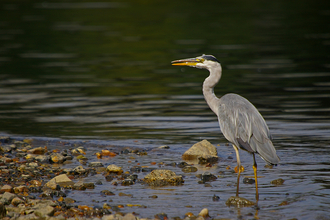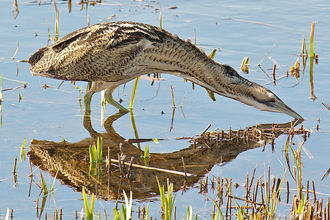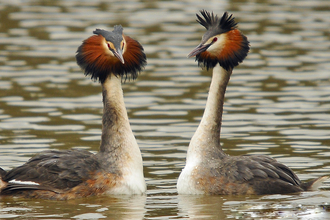Herons
The sight of a grey heron standing in solitary siege on rivers and waterways is one that is as familiar as it is bewitching. Yet for around three months of the year from February these distinctive-looking birds, with their crests, dagger bills and stilt-like legs come together to breed. A heronry is somewhere herons have nested for many generations and on certain Wildlife Trust reserves it’s possible to catch a rare glimpse of up to 40 nests teetering in the tree-tops at any one time.
With their heads drawn back and feet trailing behind, a heron almost unfurls itself into the air with its huge wings forming a curved m-shape
Find a heronry near you
Do a little research in advance and find out where your nearest heronry is. Here are 10 of the best Wildlife Trust heronry sites from across the country:
Avon Wildlife Trust
Cleeve Heronry - Home to one of the largest heronries in the southwest, more than 40 nests rest on the tops of oak and ash trees. Although access is by permit only, a nearby lay-by offers the perfect opportunity to watch adult herons fly back and forth to their Somerset fishing grounds to gather food for their young. Cleeve garden centre is next to the reserve, which has a tea shop with a camera-feed to a nest-height webcam.
The Wildlife Trust for Beds, Cambs and Northants
Titchmarsh - The enchanting Titchmarsh wetland is well-worth visiting to catch a glimpse of the heronry located in the reserve's pines. Come along in February to hear the noisy breeding calls of the herons and visit the reserve's grasslands to hear the chattering of breeding ground nesters including snipe, reed warbler and sedge warbler.
Cheshire Wildlife Trust
Trentabank Reservoir - The heronry at Trentabank Reservoir is one of the largest in the Peak District and sits within the picturesque Macclesfield Forest. More than 20 pairs of the birds nest amongst the larches toward the eastern end of the reservoir, which in winter is also regularly home to goldeneye and goosander. The surrounding forest also plays host to a secretive herd of red deer, while crossbills feed in the pine tops and peregrines, buzzards and even the occasional red kite patrol the skies above. The heronry is best viewed from the lay-by east of the ranger station and car park, while views of the reservoir can be enjoyed from the small circular path of the main Trust reserve. In some years, video footage from the heronry is also beamed to the ranger station when open to visitors.
Devon Wildlife Trust
Dunsdon - Arguably the most important Culm grassland left in England, Dunsdon Nature Reserve represents a habitat in sharp decline. The marshy, heath-like grassland supports diverse wildlife including an active heronry. Situated in the trees near the old Bude Canal, herons can be observed fishing. Barn owls also frequently use the site as a feeding ground and may be seen roosting in the trees.
Herts & Middlesex Wildlife Trust
Stocker's Lake - One of the oldest gravel pits in the Colne Valley, Stocker's Lake is home to the county’s largest heronry. Over 60 species of breeding birds have been recorded with the shoveler and golden eye being common visitors.
Nottinghamshire Wildlife Trust
Besthorpe Nature Reserve is comprised of three distinct habitat types: open water with islands, reedbeds and shingle – the perfect combination to support one of the largest heronries in Nottinghamshire. For many years, young herons have been counted and ringed at Besthorpe and it was due to such efforts that a decline in the region’s heron chicks was noted. Dedicated work by the North Nottinghamshire Ringing Group and support by the Environment Agency identified that local pollution was causing the chicks' bones to become brittle, endangering their chances of survival. Pollution in the region has now been eliminated, while monitoring of the heron chicks is still ongoing. Plenty of hides are located around the southern area where herons can be spotted visiting the pool for fish.
The 145 hectare Attenborough Nature Reserve’s flooded gravel pits and islands provide the ideal habitat to support the region’s largest heronry. Known as the Attenborough heronry, the first nest was recorded in 2007, which over the years, has increased to an impressive 40 nests. Around 30 of these can be easily spotted around Tween Pond.
The Nottinghamshire Wildlife Trust has been responsible for monitoring heron numbers through the Heronries Census at the Attenborough reserve – a valuable indicator of the quality of the wetland habitat. The reserve is also an important site for winter wildfowl and often holds a high proportion of the county’s shoveler and diving ducks including mallard and teal.
Shropshire Wildlife Trust
One of the easiest heronries to get to and view in the UK can be found in Ellesmere, Shropshire, where nesting herons return each year to Moscow Island. Using the artificial island built in the early 19th Century to raise their young, the heronry is growing in numbers.
Pop into the Ellesmere Shropshire Wildlife Trust visitor centre to watch the live camera feed. Herons gathering and delivering nesting material can be seen in February, while come May, watch the herons lay their first eggs.
Ulster Wildlife Trust
Located south of Maghera, Ballynahone Bog is the largest of Ulster Wildlife Trust’s nature reserves and has an incredible range of bog flora, including nationally rare sphagnum mosses, liverworts and bog rosemary. The reserve’s heronry can be found in the bog’s surrounding birch woodland. The biggest known colony of the large heath butterfly in Northern Ireland is also found here.
Yorkshire Wildlife Trust
Kirkstall Valley - Just outside the urban heart of Leeds, Leeds City Council's Kirkstall Valley Nature Reserve combines the industrial past with today's vibrant wildlife communities. A keen eye might spot otters or kingfishers by the weirs on the River Aire.
Burton Riggs - The large, open lakes at Burton Riggs make it a fantastic place to watch wildfowl and waders, particularly during autumn migration and over the winter months.
Letchmire Pastures - When the sun begins to shine and the days get longer delicate bee orchids bloom in this wild, reclaimed former colliery site, where meadows and a young woodland thrive and various dragonfly species dominate the wetland.
What to look for
The striking appearance of the grey heron is not easily mistaken. Heronries, as well as offering a chance to see nesting behaviour, are also excellent places to watch herons fly. Listen out too for its distinctive kronking bark. Generally arriving in February, herons often lay their eggs in the same nests each year, hatching between March and April. For your best chance of spotting a nestling, visit in April when nests are usually still visible before they are obscured by tree leaves.
If you can't get to a heronry
If you can't get to a heronry, it’s still worthwhile looking out for herons hunting near you. Herons can be found across the UK, from urban and suburban habitats to the countryside and coast. A voracious feeder on fish, they also will take ducklings, small mammals like voles and amphibians. Look out for herons hunting in fields too, where after harvest time, they can be seen watching and waiting for rodents.
More wildlife experiences
From seeing colourful wildflowers to spotting magnificent birds of prey, we can help you get closer to wildlife across the UK.








